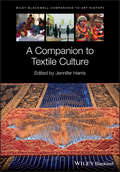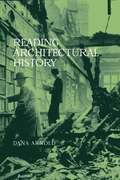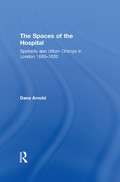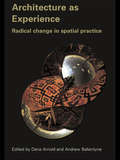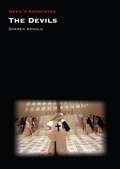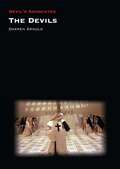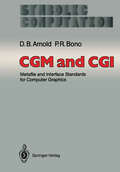- Table View
- List View
A Companion to Modern Art (Blackwell Companions to Art History)
by Dana ArnoldA Companion to Modern Art presents a series of original essays by international and interdisciplinary authors who offer a comprehensive overview of the origins and evolution of artistic works, movements, approaches, influences, and legacies of Modern Art. Presents a contemporary debate and dialogue rather than a seamless consensus on Modern Art Aims for reader accessibility by highlighting a plurality of approaches and voices in the field Presents Modern Art’s foundational philosophic ideas and practices, as well as the complexities of key artists such as Cezanne and Picasso, and those who straddled the modern and contemporary Looks at the historical reception of Modern Art, in addition to the latest insights of art historians, curators, and critics to artists, educators, and more
A Companion to Modern Art (Blackwell Companions to Art History)
by Dana ArnoldA Companion to Modern Art presents a series of original essays by international and interdisciplinary authors who offer a comprehensive overview of the origins and evolution of artistic works, movements, approaches, influences, and legacies of Modern Art. Presents a contemporary debate and dialogue rather than a seamless consensus on Modern Art Aims for reader accessibility by highlighting a plurality of approaches and voices in the field Presents Modern Art’s foundational philosophic ideas and practices, as well as the complexities of key artists such as Cezanne and Picasso, and those who straddled the modern and contemporary Looks at the historical reception of Modern Art, in addition to the latest insights of art historians, curators, and critics to artists, educators, and more
A Companion to Nineteenth-Century Art (Blackwell Companions to Art History)
by Dana ArnoldA comprehensive review of art in the first truly modern century A Companion to Nineteenth-Century Art contains contributions from an international panel of noted experts to offer a broad overview of both national and transnational developments, as well as new and innovative investigations of individual art works, artists, and issues. The text puts to rest the skewed perception of nineteenth-century art as primarily Paris-centric by including major developments beyond the French borders. The contributors present a more holistic and nuanced understanding of the art world during this first modern century. In addition to highlighting particular national identities of artists, A Companion to Nineteenth-Century Art also puts the focus on other aspects of identity including individual, ethnic, gender, and religious. The text explores a wealth of relevant topics such as: the challenges the artists faced; how artists learned their craft and how they met clients; the circumstances that affected artist’s choices and the opportunities they encountered; and where the public and critics experienced art. This important text: Offers a comprehensive review of nineteenth-century art that covers the most pressing issues and significant artists of the era Covers a wealth of important topics such as: ethnic and gender identity, certain general trends in the nineteenth century, an overview of the art market during the period, and much more Presents novel and valuable insights into familiar works and their artists Written for students of art history and those studying the history of the nineteenth century, A Companion to Nineteenth-Century Art offers a comprehensive review of the first modern era art with contributions from noted experts in the field.
A Companion to Nineteenth-Century Art (Blackwell Companions to Art History)
by Dana ArnoldA comprehensive review of art in the first truly modern century A Companion to Nineteenth-Century Art contains contributions from an international panel of noted experts to offer a broad overview of both national and transnational developments, as well as new and innovative investigations of individual art works, artists, and issues. The text puts to rest the skewed perception of nineteenth-century art as primarily Paris-centric by including major developments beyond the French borders. The contributors present a more holistic and nuanced understanding of the art world during this first modern century. In addition to highlighting particular national identities of artists, A Companion to Nineteenth-Century Art also puts the focus on other aspects of identity including individual, ethnic, gender, and religious. The text explores a wealth of relevant topics such as: the challenges the artists faced; how artists learned their craft and how they met clients; the circumstances that affected artist’s choices and the opportunities they encountered; and where the public and critics experienced art. This important text: Offers a comprehensive review of nineteenth-century art that covers the most pressing issues and significant artists of the era Covers a wealth of important topics such as: ethnic and gender identity, certain general trends in the nineteenth century, an overview of the art market during the period, and much more Presents novel and valuable insights into familiar works and their artists Written for students of art history and those studying the history of the nineteenth century, A Companion to Nineteenth-Century Art offers a comprehensive review of the first modern era art with contributions from noted experts in the field.
A Companion to Public Art (Blackwell Companions to Art History)
by Dana ArnoldA Companion to Public Art is the only scholarly volume to examine the main issues, theories, and practices of public art on a comprehensive scale. Edited by two distinguished scholars with contributions from art historians, critics, curators, and art administrators, as well as artists themselves Includes 19 essays in four sections: tradition, site, audience, and critical frameworks Covers important topics in the field, including valorizing victims, public art in urban landscapes and on university campuses, the role of digital technologies, jury selection committees, and the intersection of public art and mass media Contains “artist’s philosophy” essays, which address larger questions about an artist’s body of work and the field of public art, by Julian Bonder, eteam (Hajoe Moderegger and Franziska Lamprecht), John Craig Freeman, Antony Gormley, Suzanne Lacy, Caleb Neelon, Tatzu Nishi, Greg Sholette, and Alan Sonfist.
A Companion to Public Art (Blackwell Companions to Art History)
by Dana ArnoldA Companion to Public Art is the only scholarly volume to examine the main issues, theories, and practices of public art on a comprehensive scale. Edited by two distinguished scholars with contributions from art historians, critics, curators, and art administrators, as well as artists themselves Includes 19 essays in four sections: tradition, site, audience, and critical frameworks Covers important topics in the field, including valorizing victims, public art in urban landscapes and on university campuses, the role of digital technologies, jury selection committees, and the intersection of public art and mass media Contains “artist’s philosophy” essays, which address larger questions about an artist’s body of work and the field of public art, by Julian Bonder, eteam (Hajoe Moderegger and Franziska Lamprecht), John Craig Freeman, Antony Gormley, Suzanne Lacy, Caleb Neelon, Tatzu Nishi, Greg Sholette, and Alan Sonfist.
A Companion to Renaissance and Baroque Art (Blackwell Companions to Art History #29)
by Dana ArnoldA Companion to Renaissance and Baroque Art provides a diverse, fresh collection of accessible, comprehensive essays addressing key issues for European art produced between 1300 and 1700, a period that might be termed the beginning of modern history. Presents a collection of original, in-depth essays from art experts that address various aspects of European visual arts produced from circa 1300 to 1700 Divided into five broad conceptual headings: Social-Historical Factors in Artistic Production; Creative Process and Social Stature of the Artist; The Object: Art as Material Culture; The Message: Subjects and Meanings; and The Viewer, the Critic, and the Historian: Reception and Interpretation as Cultural Discourse Covers many topics not typically included in collections of this nature, such as Judaism and the arts, architectural treatises, the global Renaissance in arts, the new natural sciences and the arts, art and religion, and gender and sexuality Features essays on the arts of the domestic life, sexuality and gender, and the art and production of tapestries, conservation/technology, and the metaphor of theater Focuses on Western and Central Europe and that territory's interactions with neighboring civilizations and distant discoveries Includes illustrations as well as links to images not included in the book
A Companion to Renaissance and Baroque Art (Blackwell Companions to Art History #28)
by Dana ArnoldA Companion to Renaissance and Baroque Art provides a diverse, fresh collection of accessible, comprehensive essays addressing key issues for European art produced between 1300 and 1700, a period that might be termed the beginning of modern history. Presents a collection of original, in-depth essays from art experts that address various aspects of European visual arts produced from circa 1300 to 1700 Divided into five broad conceptual headings: Social-Historical Factors in Artistic Production; Creative Process and Social Stature of the Artist; The Object: Art as Material Culture; The Message: Subjects and Meanings; and The Viewer, the Critic, and the Historian: Reception and Interpretation as Cultural Discourse Covers many topics not typically included in collections of this nature, such as Judaism and the arts, architectural treatises, the global Renaissance in arts, the new natural sciences and the arts, art and religion, and gender and sexuality Features essays on the arts of the domestic life, sexuality and gender, and the art and production of tapestries, conservation/technology, and the metaphor of theater Focuses on Western and Central Europe and that territory's interactions with neighboring civilizations and distant discoveries Includes illustrations as well as links to images not included in the book
A Companion to Textile Culture (Blackwell Companions to Art History)
by Dana ArnoldA lively and innovative collection of new and recent writings on the cultural contexts of textiles The study of textile culture is a dynamic field of scholarship which spans disciplines and crosses traditional academic boundaries. A Companion to Textile Culture is an expertly curated compendium of new scholarship on both the historical and contemporary cultural dimensions of textiles, bringing together the work of an interdisciplinary team of recognized experts in the field. The Companion provides an expansive examination of textiles within the broader area of visual and material culture, and addresses key issues central to the contemporary study of the subject. A wide range of methodological and theoretical approaches to the subject are explored—technological, anthropological, philosophical, and psychoanalytical, amongst others—and developments that have influenced academic writing about textiles over the past decade are discussed in detail. Uniquely, the text embraces archaeological textiles from the first millennium AD as well as contemporary art and performance work that is still ongoing. This authoritative volume: Offers a balanced presentation of writings from academics, artists, and curators Presents writings from disciplines including histories of art and design, world history, anthropology, archaeology, and literary studies Covers an exceptionally broad chronological and geographical range Provides diverse global, transnational, and narrative perspectives Included numerous images throughout the text to illustrate key concepts A Companion to Textile Culture is an essential resource for undergraduate and postgraduate students, instructors, and researchers of textile history, contemporary textiles, art and design, visual and material culture, textile crafts, and museology.
A Companion to Textile Culture (Blackwell Companions to Art History)
by Dana ArnoldA lively and innovative collection of new and recent writings on the cultural contexts of textiles The study of textile culture is a dynamic field of scholarship which spans disciplines and crosses traditional academic boundaries. A Companion to Textile Culture is an expertly curated compendium of new scholarship on both the historical and contemporary cultural dimensions of textiles, bringing together the work of an interdisciplinary team of recognized experts in the field. The Companion provides an expansive examination of textiles within the broader area of visual and material culture, and addresses key issues central to the contemporary study of the subject. A wide range of methodological and theoretical approaches to the subject are explored—technological, anthropological, philosophical, and psychoanalytical, amongst others—and developments that have influenced academic writing about textiles over the past decade are discussed in detail. Uniquely, the text embraces archaeological textiles from the first millennium AD as well as contemporary art and performance work that is still ongoing. This authoritative volume: Offers a balanced presentation of writings from academics, artists, and curators Presents writings from disciplines including histories of art and design, world history, anthropology, archaeology, and literary studies Covers an exceptionally broad chronological and geographical range Provides diverse global, transnational, and narrative perspectives Included numerous images throughout the text to illustrate key concepts A Companion to Textile Culture is an essential resource for undergraduate and postgraduate students, instructors, and researchers of textile history, contemporary textiles, art and design, visual and material culture, textile crafts, and museology.
Reading Architectural History
by Dana ArnoldArchitectural history is more than just the study of buildings. Architecture of the past and present remains an essential emblem of a distinctive social system and set of cultural values and as a result it has been the subject of study of a variety of disciplines. But what is architectural history and how should we read it?Reading Architectural History examines the historiographic and socio/cultural implications of the mapping of British architectural history with particular reference to eighteenth - and nineteenth-century Britain. Discursive essays consider a range of writings from biographical and social histories to visual surveys and guidebooks to examine the narrative structures of histories of architecture and their impact on perception adn understanding of the architecture of the past. Alongside this, each chapter cites canonical histories juxtaposed with a range of social and cultural theorists, to reveal that these writings are richer than we have perhaps recognised and that architectural production in this period can in interrogated in the same way as that from more recent past - and can be read in a variety of ways. The essays and texts combine to form an essential course reader for methods and critical approached to architectural history, and more generally as examples of the kind of evidence used in the formation of architectural histories, while also offering a thematic introduction to architecture in Britain and its social and cultural meaning.
Reading Architectural History
by Dana ArnoldArchitectural history is more than just the study of buildings. Architecture of the past and present remains an essential emblem of a distinctive social system and set of cultural values and as a result it has been the subject of study of a variety of disciplines. But what is architectural history and how should we read it?Reading Architectural History examines the historiographic and socio/cultural implications of the mapping of British architectural history with particular reference to eighteenth - and nineteenth-century Britain. Discursive essays consider a range of writings from biographical and social histories to visual surveys and guidebooks to examine the narrative structures of histories of architecture and their impact on perception adn understanding of the architecture of the past. Alongside this, each chapter cites canonical histories juxtaposed with a range of social and cultural theorists, to reveal that these writings are richer than we have perhaps recognised and that architectural production in this period can in interrogated in the same way as that from more recent past - and can be read in a variety of ways. The essays and texts combine to form an essential course reader for methods and critical approached to architectural history, and more generally as examples of the kind of evidence used in the formation of architectural histories, while also offering a thematic introduction to architecture in Britain and its social and cultural meaning.
The Spaces of the Hospital: Spatiality and Urban Change in London 1680-1820
by Dana ArnoldThe Spaces of the Hospital examines how hospitals operated as a complex category of social, urban and architectural space in London from 1680 to 1820. This period witnessed the transformation of the city into a modern metropolis. The hospital was very much part of this process and its spaces, both interior and exterior, help us to understand these changes in terms of spatiality and spatial practices. Exploring the hospital through a series of thematic case studies, Dana Arnold presents a theoretically refined reading of how these institutions both functioned as internal discrete locations and interacted with the metropolis. Examples range from the grand royal military hospital, those concerned with the destitute and the insane and the new cultural phenomenon of the voluntary hospital. This engaging book makes an important contribution to our understanding of urban space and of London, uniquely examining how different theoretical paradigms reveal parallel readings of these remarkable hospital buildings.
The Spaces of the Hospital: Spatiality and Urban Change in London 1680-1820
by Dana ArnoldThe Spaces of the Hospital examines how hospitals operated as a complex category of social, urban and architectural space in London from 1680 to 1820. This period witnessed the transformation of the city into a modern metropolis. The hospital was very much part of this process and its spaces, both interior and exterior, help us to understand these changes in terms of spatiality and spatial practices. Exploring the hospital through a series of thematic case studies, Dana Arnold presents a theoretically refined reading of how these institutions both functioned as internal discrete locations and interacted with the metropolis. Examples range from the grand royal military hospital, those concerned with the destitute and the insane and the new cultural phenomenon of the voluntary hospital. This engaging book makes an important contribution to our understanding of urban space and of London, uniquely examining how different theoretical paradigms reveal parallel readings of these remarkable hospital buildings.
Women and Architectural History: The Monstrous Regiment Then and Now
by Dana ArnoldIn this book, prominent architectural historians, who happen to be women, reflect on their practice and the intervention this has made in the discipline. Of particular concern are the ways in which feminine subjectivities have been embodied in the discourses of architectural history. Each of the chapters examines the author’s own position and the disruptive presence of women as both subject and object in the historiography of a specific field of enquiry. The aim is not to replace male lives with female lives, or to write women into the masculinist narratives of architectural history. Instead, this book aims to broaden the discourses of architectural history to explore how the potentially ‘unnatural rule’ of women subverts canonical norms through the empowerment of otherness rather than a process of perceived emasculation.The essays examine the historiographic and socio/cultural implications of the role of women in the narratives and writing of architectural history with particular reference to Western traditions of scholarship on the period 1600–1950. Rather than subscribing to a single position, individual voices critically engage with past and present canonical histories disclosing assumptions, biases, and absences in the architectural historiography of the West. This book is a crucial reflection upon historiographical practice, exploring potential openings that may contribute further transformation of the theory and methods of architectural history.Chapter 9 of this book is freely available as a downloadable Open Access PDF at http://www.taylorfrancis.com under a Creative Commons Attribution-NonCommercial-NoDerivatives (CC-BY-NC-ND) 4.0 International license.
Women and Architectural History: The Monstrous Regiment Then and Now
by Dana ArnoldIn this book, prominent architectural historians, who happen to be women, reflect on their practice and the intervention this has made in the discipline. Of particular concern are the ways in which feminine subjectivities have been embodied in the discourses of architectural history. Each of the chapters examines the author’s own position and the disruptive presence of women as both subject and object in the historiography of a specific field of enquiry. The aim is not to replace male lives with female lives, or to write women into the masculinist narratives of architectural history. Instead, this book aims to broaden the discourses of architectural history to explore how the potentially ‘unnatural rule’ of women subverts canonical norms through the empowerment of otherness rather than a process of perceived emasculation.The essays examine the historiographic and socio/cultural implications of the role of women in the narratives and writing of architectural history with particular reference to Western traditions of scholarship on the period 1600–1950. Rather than subscribing to a single position, individual voices critically engage with past and present canonical histories disclosing assumptions, biases, and absences in the architectural historiography of the West. This book is a crucial reflection upon historiographical practice, exploring potential openings that may contribute further transformation of the theory and methods of architectural history.Chapter 9 of this book is freely available as a downloadable Open Access PDF at http://www.taylorfrancis.com under a Creative Commons Attribution-NonCommercial-NoDerivatives (CC-BY-NC-ND) 4.0 International license.
Architecture as Experience: Radical Change in Spatial Practice
by Dana Arnold Andrew BallantyneArchitecture as Experience investigates the perception and appropriation of places across intervals of time and culture. The particular concern of the volume is to bring together fresh empirical research and animate it through contact with theoretical sophistication, without overwhelming the material. The chapters establish the continuity of a particular physical object and show it in at least two alternative historical perspectives, in which recognisable features are shown in different lights. The results are often surprising, inverting the common idea of a historic place as having an enduring meaning. This book shows the insight that can be gained from learning about earlier constructions of meaning which have been derived from the same buildings that stand before us today.
Architecture as Experience: Radical Change in Spatial Practice
by Dana Arnold Andrew BallantyneArchitecture as Experience investigates the perception and appropriation of places across intervals of time and culture. The particular concern of the volume is to bring together fresh empirical research and animate it through contact with theoretical sophistication, without overwhelming the material. The chapters establish the continuity of a particular physical object and show it in at least two alternative historical perspectives, in which recognisable features are shown in different lights. The results are often surprising, inverting the common idea of a historic place as having an enduring meaning. This book shows the insight that can be gained from learning about earlier constructions of meaning which have been derived from the same buildings that stand before us today.
Rethinking Architectural Historiography
by Dana Arnold Elvan Altan Ergut Belgin Turan ÖzkayaRather than subscribing to a single position, this collection informs the reader about the current state of the discipline looking at changes across the broad field of methodological, theoretical and geographical plurality. Divided into three sections, Rethinking Architectural Historiography begins by renegotiating foundational and contemporary boundaries of architectural history in relation to other fields, such as art history and archaeology. It then goes on to critically engage with past and present histories, disclosing assumptions, biases and absences in architectural historiography. It concludes by exploring the possibilities provided by new perspectives, reframing the discipline in the light of new parameters and problematics. This timely and illustrated title reflects upon the current changes in historiographical practice, exploring potential openings that may contribute further transformation of the disciplines and theories on architectural historiography and addresses the current question of the disciplinary particularity of architectural history.
Rethinking Architectural Historiography
by Dana Arnold Elvan Altan Ergut Belgin Turan OzkayaRather than subscribing to a single position, this collection informs the reader about the current state of the discipline looking at changes across the broad field of methodological, theoretical and geographical plurality. Divided into three sections, Rethinking Architectural Historiography begins by renegotiating foundational and contemporary boundaries of architectural history in relation to other fields, such as art history and archaeology. It then goes on to critically engage with past and present histories, disclosing assumptions, biases and absences in architectural historiography. It concludes by exploring the possibilities provided by new perspectives, reframing the discipline in the light of new parameters and problematics. This timely and illustrated title reflects upon the current changes in historiographical practice, exploring potential openings that may contribute further transformation of the disciplines and theories on architectural historiography and addresses the current question of the disciplinary particularity of architectural history.
Art and Thought (New Interventions in Art History)
by Dana Arnold Margaret IversenArt and Thought is a collection of newly commissioned essays that explores the relationship between the discipline of art history and important movements in the history of western thought. Brings together newly commissioned essays that explore the relationship between the discipline of art history and movements in the history of western thought. Considers the impact of the writings of key thinkers, including Aristotle, Kant, and Heidegger, on the way in which objects are perceived and understood and histories of art are constructed, deconstructed, and reconfigured according to varying sets of philosophical frameworks. Introduces the reader to the dynamic interface between philosophical reflections and art practices. Part of the New Interventions in Art History series, which is published in conjunction with the Association of Art Historians.
The Devils (Devil's Advocates)
by Darren ArnoldUndoubtedly the most notorious title in director Ken Russell’s controversial filmography, The Devils (1973) caused a real furor on its initial theatrical release, only to largely disappear for many years. This Devil’s Advocate considers the film’s historical context, as the timing of the first appearance of The Devils is of particular importance, its authorship and adaptation (Russell’s auteur reputation aside, the screenplay is based on John Whiting’s 1961 play of the same name, which was in turn based on Aldous Huxley’s 1952 book The Devils of Loudun), and its generic hybridity. Darren Arnold goes on to examine the themes prevalent in the film—this is the only film of Russell’s which the director considered to be political—and considers the representation of gender and sexuality, gender fluidity, and how sex and religion clash to interesting and controversial effect. He concludes by revisiting the film’s censorship travails and the various versions of The Devils that have appeared on both big and small screens, and the film’s legacy and influence.
The Devils (Devil's Advocates)
by Darren ArnoldUndoubtedly the most notorious title in director Ken Russell’s controversial filmography, The Devils (1973) caused a real furor on its initial theatrical release, only to largely disappear for many years. This Devil’s Advocate considers the film’s historical context, as the timing of the first appearance of The Devils is of particular importance, its authorship and adaptation (Russell’s auteur reputation aside, the screenplay is based on John Whiting’s 1961 play of the same name, which was in turn based on Aldous Huxley’s 1952 book The Devils of Loudun), and its generic hybridity. Darren Arnold goes on to examine the themes prevalent in the film—this is the only film of Russell’s which the director considered to be political—and considers the representation of gender and sexuality, gender fluidity, and how sex and religion clash to interesting and controversial effect. He concludes by revisiting the film’s censorship travails and the various versions of The Devils that have appeared on both big and small screens, and the film’s legacy and influence.
CGM and CGI: Metafile and Interface Standards for Computer Graphics (Symbolic Computation)
by David B. Arnold Peter R. BonoWe have written this book principally for users and practitioners of computer graphics. In particular, system designers, independent software vendors, graphics system implementers, and application program developers need to understand the basic standards being put in place at the so-called Virtual Device Interface and how they relate to other industry standards, both formal and de facto. Secondarily, the book has been targetted at technical managers and advanced students who need some understanding of the graphics standards and how they fit together, along with a good overview of the Computer Graphics Interface (CGI) proposal and Computer Graphics Metafile (CGM) standard in particular. Part I, Chapters 1,2, and 3; Part II, Chapters 10 and 11; Part III, Chapters 15, 16, and 17; and some of the Appendices will be of special interest. Finally, these same sections will interest users in government and industry who are responsible for selecting, buying and installing commercial implementations of the standards. The CGM is already a US Federal Information Processing Standard (FIPS 126), and we expect the same status for the CGI when its development is completed and it receives formal approval by the standards-making bodies.
Islamic Palace Architecture in the Western Mediterranean: A History
by Felix ArnoldPalaces like the Aljafería and the Alhambra rank among the highest achievements of the Islamic world. In recent years archaeological work at Córdoba, Kairouan and many other sites has vastly increased our knowledge about the origin and development of Islamic palatial architecture, particularly in the Western Mediterranean region. This book offers a comprehensive and up-to-date overview of Islamic palace architecture in Spain, Morocco, Algeria, Tunisia and southern Italy. The author, who has himself conducted archaeological field work at several prominent sites, presents all Islamic palaces known in the region in ground plans, sections and individual descriptions. The book traces the evolution of Islamic palace architecture in the region from the 8th to the 19th century and places them within the context of the history of Islamic culture. Palace architecture is a unique source of cultural history, offering insights into the way space was conceived and the way rulers used architecture to legitimize their power. The book discusses such topics as the influence of the architecture of the Middle East on the Islamic palaces of the western Mediterranean region, the role of Greek logic and scientific progress on the design of palaces, the impact of Islamic palaces on Norman and Gothic architecture and the role of Sufism on the palatial architecture of the late medieval period.




